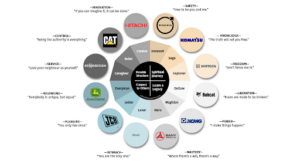Brand Identity = Measurable Customer Behaviors
Brand Identity = Measurable Customer Behaviors
Today’s blog post, “Brand Identity = Measurable Customer Behaviors,” is brought to you from a new contributor. Roy Lapa is an experienced marketing professional with 25+ years of experience in B2B and B2B2C heavy industries in various functions such as sales, customer service, remanufacturing, industrial automation, product support, marketing, and management (with over 10 at senior levels). Roy’s DNA is geared toward developing solutions that are data-driven, customer-focused, and innovative. Roy is the Managing Director & Co-Founder, AFP Marketing Agency LDA.
If you search online, you’ll find many different brand identity definitions that point to various components such as your values, communication style, what you want people to feel when they interact with you, how recognizable you are, promises you make, tone, voice, fonts, colours, etc. These achieve some level of awareness but lack tangibility for most industrial businesses. Let’s narrow the definition to something more tactile for industry manufacturers, dealers, distributors, and service providers:
Your distinct brand identity must be linked to repeatable, scalable, and measurable customer behaviours.
Archetypes
Archetypes have proven useful as a simple framework in helping define customer behaviours since they play a role in influencing human behaviour, according to Carl G. Jung1, a Swiss psychiatrist and psychoanalyst. With some industry input, I have mapped out some of the top mining and construction manufacturers onto the 12 brand archetypes illustration2. Though there may be some debate about each OEM placement, this simply serves as an example to help you figure out your brand-customer relationship.
Here are a couple of questions and an example for each to assist you in defining your brand-customer relationship.
Why am I here as a Manufacturer, Dealer, Distributor, or After Sales Provider?
Example: Mountain snow groomers keep failing within the warranty period leaving the customer unsuccessful in figuring out why. They follow all the OEM recommendations to no avail.
- [MASTERY-HERO] If you have a reputation for saving the day, one of your service managers is likely one of the customer’s ‘pinned’ text message contacts.
2-way relationship behaviour: Under customer pressure, you always figure out a way.
What primary market behaviour do I want to be known for?
Example: Looking for help completing a new and unique infrastructure project, a customer is unsure how to approach the project from a technical standpoint.
- [INNOVATION-CREATOR] You have a better chance of being the first contact if you have a reputation for coming up with innovative job site solutions.
2-way relationship behaviour: When the customer asks if there a better way, you consistently invent.
This is not new, and yet in dealing with many companies, most want to leap forward to brand identity deliverables such as voice, logo, typography, colours, etc. Additionally, firms are eager to transition to using terminology that is recognized in the business world without first doing a strategic analysis of their primary purpose: a behaviour-oriented relationship. Exploring your core business archetype is an excellent way to discover your brand identity.
Brand Audit
An audit performed by an external company that employs a mixture of data science and interpretation, along with contextual industry insight provides a clear anchor point which will help you understand where you stand today. Reducing self-serving bias, illuminating internal blind areas, and deciphering what is authentic vs. noise requires effort. Further, strong biases result from relying only on internal personal experience, especially recent experiences, in evaluating what your organization’s archetype might be. Lastly, brand identity is unique to your business and if you want your customer to notice you walking down the street and actively seek to engage, being distinct is key.
Great job, you narrowed it down to one brand archetype. Although it may be possible to be known for more than one, be cautious you don’t mistake that as being able to provide something for everybody. In working with many organizations, I have seen less than a handful of organizations be successfully known for two archetypes and this rare phenomenon is usually only within a distinct division or subsidiary.
Align
Now comes the challenging part. All facets within your company’s behaviours and communications must be in alignment if you are not already working inside your core archetype to undergo a thorough transformation. What do we mean by all?
- Executives, senior leaders, and managers: leading by example, living and breathing the company ‘motto’ in all internal and external interactions.
- Marketing: Events, press releases, product launches, website, content strategy, publications, social media posts, point-of-display areas, colours etc.
- Product Support (Parts, Service, Customer Service): phone calls, on-hold messaging, approach to the customer, warranty support responses, in-field support, mechanics’ interactions with customers, etc.
- HR: the process of communicating with employees, onboarding, ongoing training, upskilling courses, instant performance-based feedback, retiree communications (alumni), and much more.
- Finance, IT, and all operations: the behaviours within these groups need to align as they inevitably spill over into customer interactions.
Track
Let’s move on to some measurable items to help direct your path for the long term. I have selected these five metrics as they provide a few customer angles to measure. Each one progressively represents a stronger indication of the health of your brand identity demonstrating a more engaging customer behaviour.
- Digital Reviews (Trustpilot, Google Reviews, FB)
- Net Promoter Score (NPS)
- CRM rep interactions with customers (Keywords within conversations)
- Case studies and testimonials with customer name and endorsement
- Direct referrals
Are there more measurable options? Yes. Each of these five works well for most of the organizations within the equipment manufacturer, dealer, distributor, and service provider industries. From my experience, I would make a few metric adjustments, only if necessary, following your brand audit, brand identity creation, and establishment of certain fundamental joint marketing-business goals.
Real customers. Can you pick the most likely archetype that fits the quote?
- We’ve, [brand], stuck together through some tough times in the industry, and that’s helped us get through and into better days.
- The bottom line for me is that we’re building more roads since we started using [brand], and that’s what it’s all about.
- What’s important to us is that [brand] has been there for us every step of the way.
- We agreed to buy those graders without seeing them on an actual job or talking with anybody who had used them. We made the equipment deal based solely on our trust in [brand’s] recommendation.
References & Notes:
- https://en.wikipedia.org/wiki/Carl_Jung
- Illustration created from context knowledge, industry input, and online data points, March 2023.
- All brands, and original equipment manufacturer (OEM) references are owned by the respective OEM entities or their affiliates. These terms are used by AFP Marketing Agency, LDA for reference purposes only and are not intended to indicate affiliation with or approval by the OEM.
- Answers: 1. Mastery-Hero 2. Control-Ruler 3. Service-Caregiver 4. Knowledge-Sage


